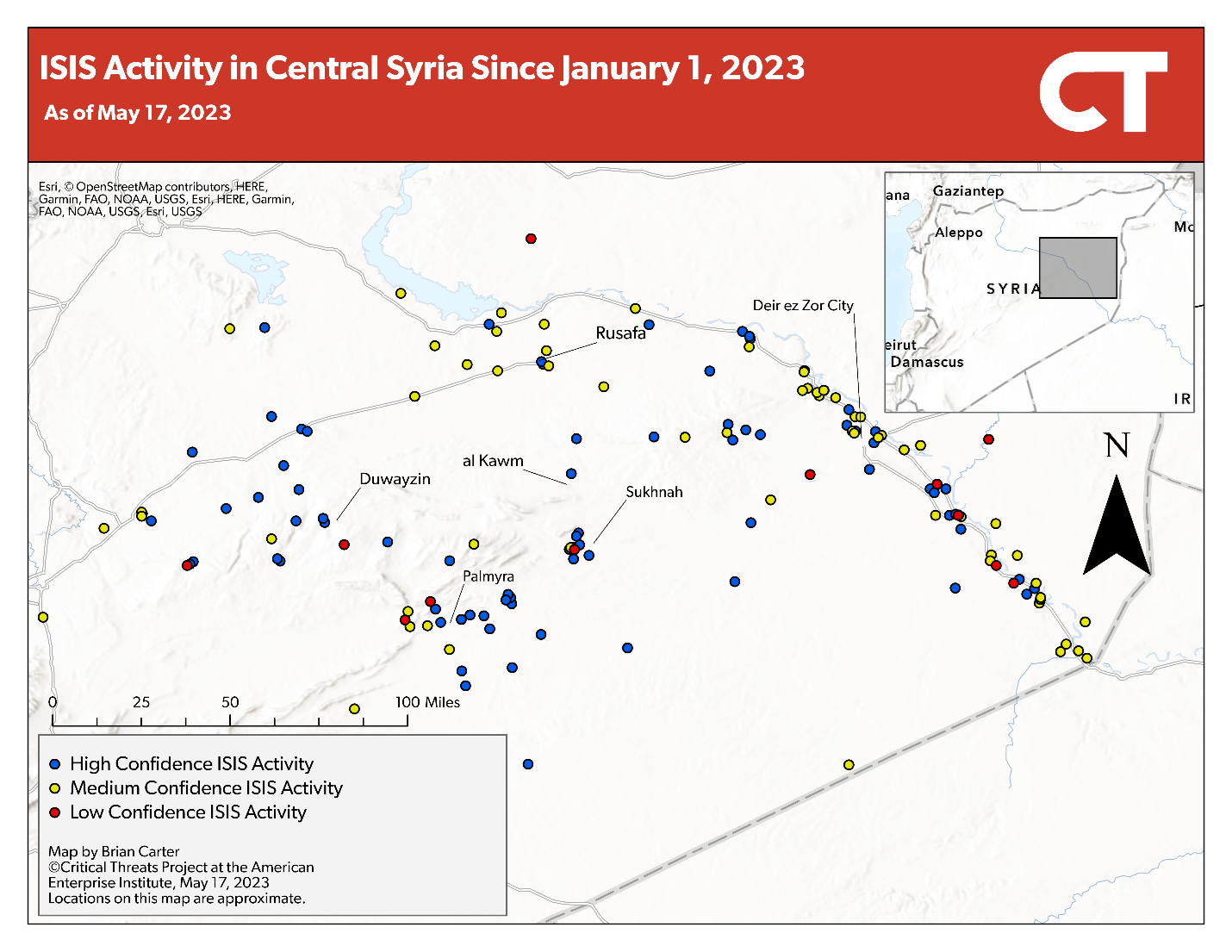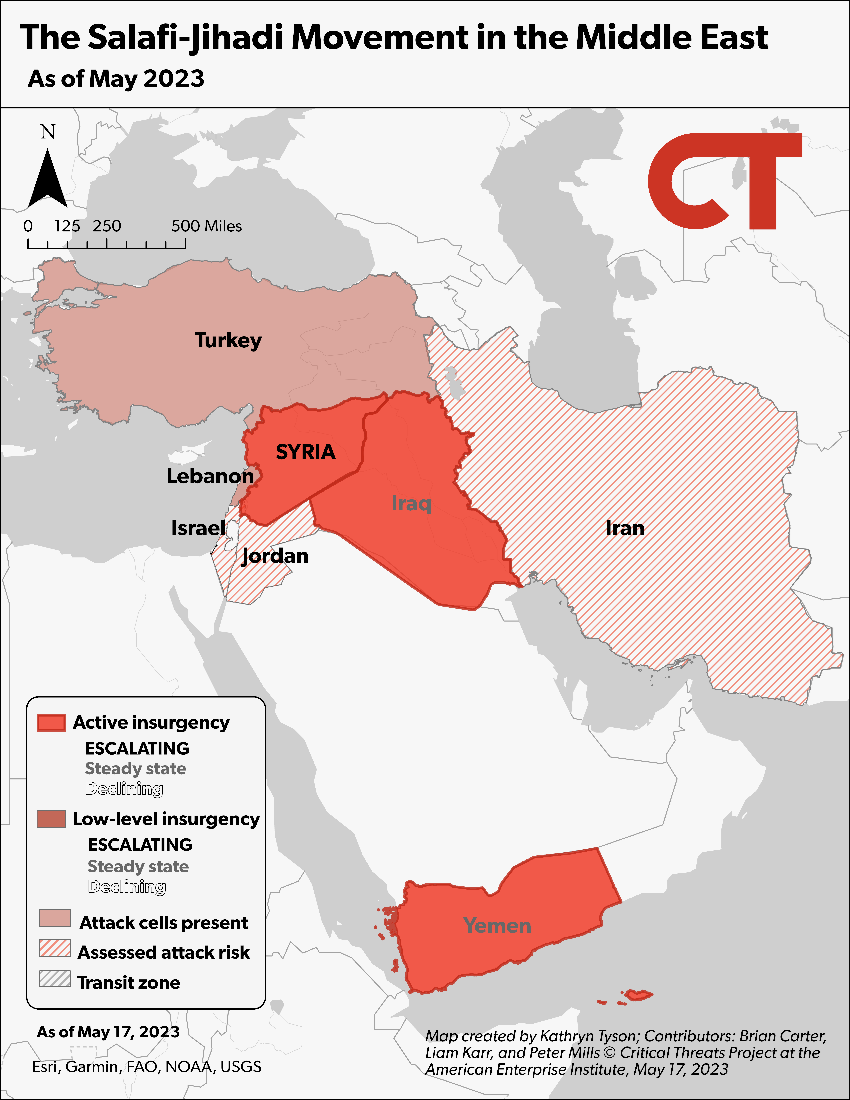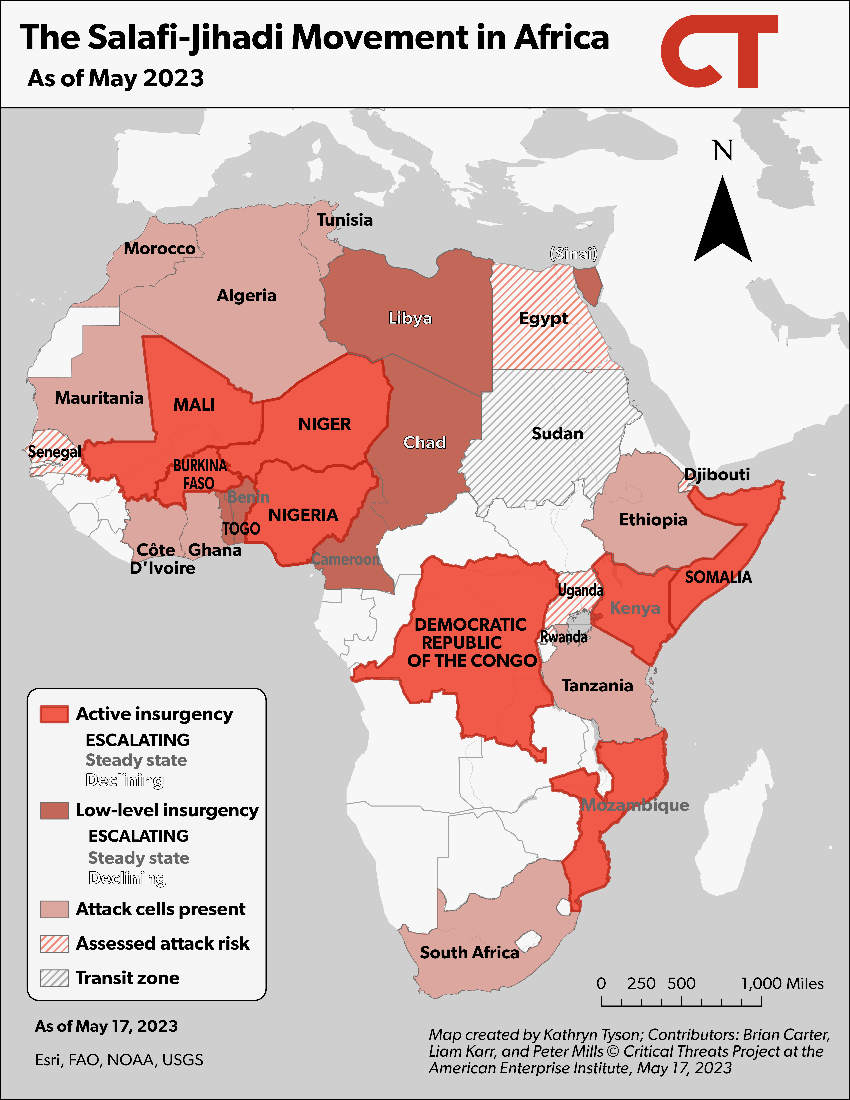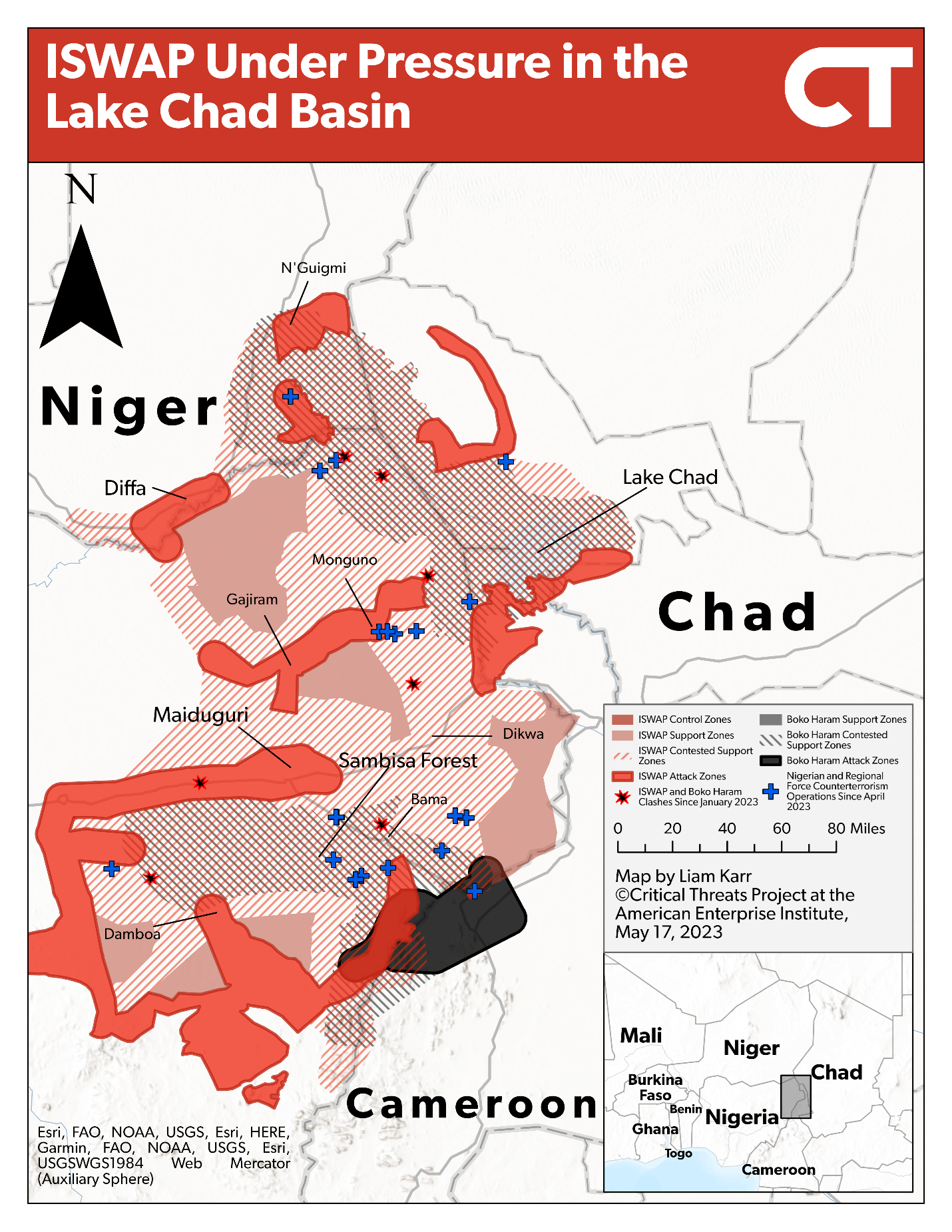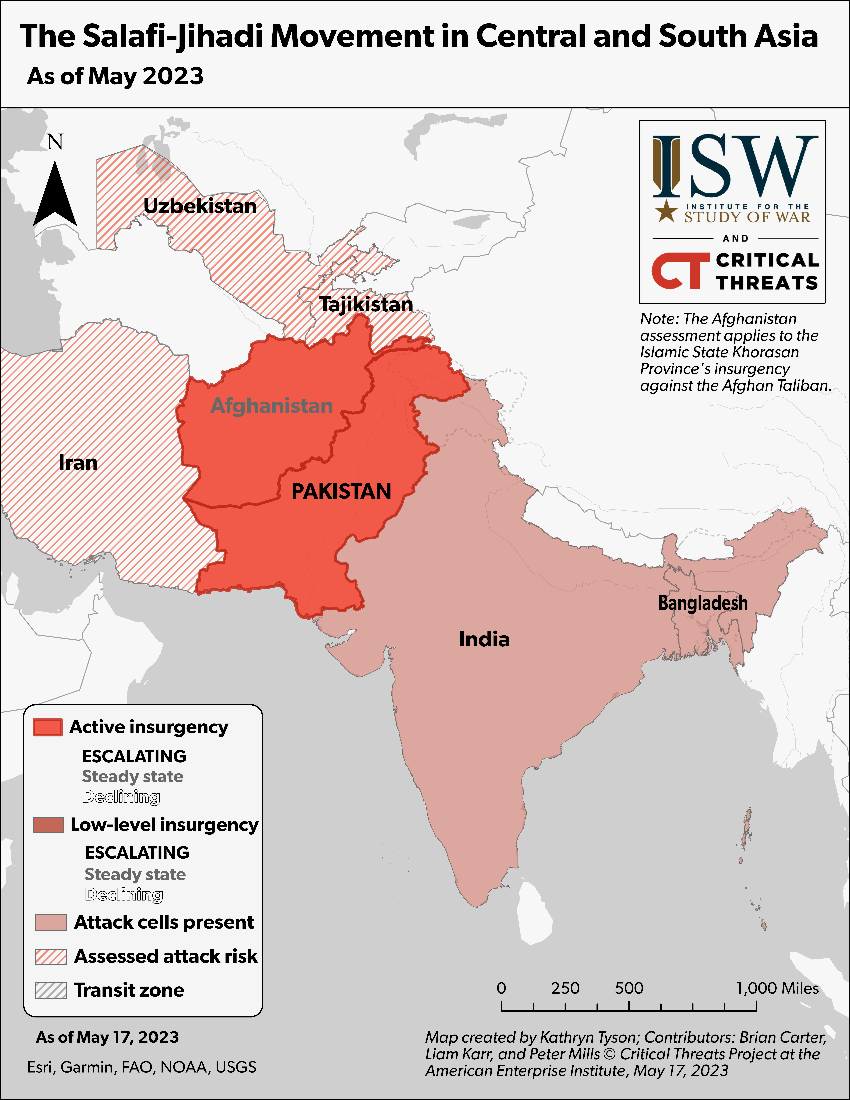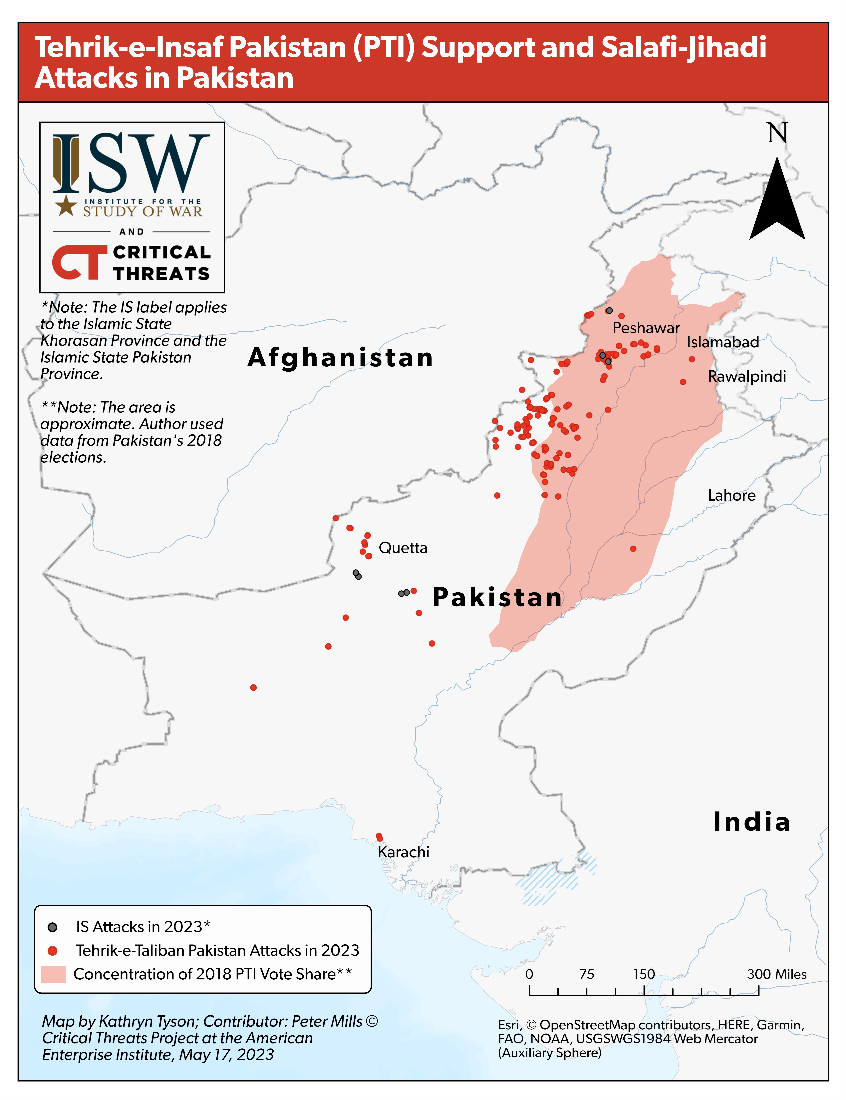 |
 |
Salafi-Jihadi Movement Weekly Update, May 17, 2023

Salafi-Jihadi Movement Weekly Update, May 17, 2023
Authors: Brian Carter, Kathryn Tyson, Liam Karr, and Peter Mills
Data Cutoff: May 17, 2023, at 10 a.m.
Key Takeaways:
Iraq and Syria. ISIS is taking advantage of the seam between Syrian territory held by the regime and the Syrian Democratic Forces (SDF) to evade counterinsurgent pressure and rebuild its insurgency. ISIS will use the seam and lack of coordination between counterterrorism forces to set conditions that will enable a rapid resurgence after a US withdrawal. US and SDF raids are successfully targeting ISIS planners, but these high-value targets will evade effective counterterrorism pressure by exfiltrating to central Syria, where US and SDF forces decline to conduct raids targeting ISIS due to regime presence. These planners will use safe havens elsewhere in Syria to plan new attacks.
Lake Chad. The recent increase in counterterrorism operations by regional forces in the Lake Chad Basin are unlikely to permanently weaken IS West Africa Province (ISWAP) because security forces cannot adequately sustain operations in the remote havens they are targeting. ISWAP is also fighting a rival Boko Haram faction, which will likely combine with the counterterrorism operations to temporarily weaken the group for several months. ISWAP will likely increase the rate and geographic scope of its attacks outside of northeastern Nigeria in response to the increased pressure. The resulting resource constraints and degraded support zones will likely proportionately degrade the regional IS support network in West Africa until ISWAP recovers.
Pakistan. Salafi-jihadi groups will likely try to exploit any banning or severe weakening of the Pakistan Tehrik-e-Insaf (PTI) party to recruit. The PTI has a stronghold in Khyber Pakhtunkhwa where Salafi-jihadi groups also have safe havens and attack frequently. The Pakistani military and government have arrested thousands of PTI leaders and supporters since Pakistan’s widespread protests on May 9–10. Pakistan’s interior minister has proposed banning the PTI. A PTI collapse would exclude the Khyber Pakhtunkhwa constituencies from mainstream politics and feed the Salafi-jihadi narrative that democratic governance is bound to fail.
Assessments:
Iraq and Syria. ISIS is taking advantage of the seam between counterinsurgency forces along the Euphrates River, which will enable the group to rebuild its insurgency free from effective counterinsurgent operations. Joint US-Syrian Democratic Forces (SDF) raids are eliminating detention planners, but ISIS planners will choose to move into safer regime-held areas where the United States and SDF do not conduct operations.[1] Insurgent commanders frequently change their tactics to avoid decapitation strikes. ISIS is conducting attacks along the river to maintain its lines of communication between regime-held and SDF-held areas.[2] The SDF and regime are unable to collaborate to close these lines of communication. Both SDF and regime forces make money from smuggling routes overlapping with the lines of communication, and the two sides frequently clash along the Euphrates, preventing cooperation.[3]
Figure 1. ISIS Activity in Central Syria Since January 1, 2023
Source: Brian Carter.
ISIS has isolated regime forces along key ground lines of communication in central Syria to regain territorial control in the central Syrian desert, which allows ISIS to create support zones in central Syria. Northeastern Syrian media outlet NPA Syria reported that ISIS set up checkpoints and patrols in some areas of Sukhnah town. Sukhnah is operationally significant because it connects Deir ez Zor city to Palmyra and southern Raqqa to Homs via al Kawm. ISIS briefly seized al Kawm in November 2022, and it fought a major battle against the Wagner Group around al Kawm in March.[4] ISIS has also isolated regime forces in the vicinity of Palmyra town and Rusafa, where improved explosive device and small arms attacks intimidate regime forces into remaining close to the towns.[5] ISIS uses its territorial control in the central Syrian desert to operate training camps there, where it can shelter key leaders and train new recruits.[6]
ISIS has successfully expanded its control into populated areas along the Euphrates River in regime-held territory, which gives ISIS access to greater resources than it can currently access in the central Syrian desert. This will permit more sophisticated attacks and greater recruitment opportunities in local communities. CTP previously assessed that ISIS was targeting a pro-regime tribe north of Deir ez Zor city, Syria, to drive a wedge between regime forces and tribal fighters in the area.[7] NPA Syria reported on May 14 that in Musayrib, a town north of Deir ez Zor, locals do not leave their homes at night for fear of ISIS and refuse to go near regime positions and offices for fear of ISIS targeting them for collaboration.[8] NPA Syria also said ISIS sometimes flies flags in the town.[9]
Mutually reinforcing ISIS campaigns on opposite sides of the seam between counterinsurgent forces along the Euphrates will allow ISIS planners and key leaders to use both the desert and the semi-urban belt to plan new attacks without meaningful counterinsurgent pressure. The United States and SDF decline to target ISIS in the regime-held semi-urban belt along the Euphrates. ISIS forces in regime-held areas are creating a rear area, which they will use to plot major attacks against detention facilities and military campaigns.[10] ISIS activities in SDF-controlled areas will enable planning for major attacks by providing intelligence and networks of safe houses the group can use to stage major attacks.
The regime is not supporting ISIS, but it is unable to contain the group. The regime’s forces in central Syria are confined to urban areas and defenses of critical infrastructure in the central Syrian desert, and they do not conduct meaningful counter-ISIS operations. The last fully successful regime operation recaptured al Kawm from ISIS in December 2022, but only after a delay caused by fuel shortages, and it relied on support from Russian aircraft.[11] Regime forces operating outside urban areas in the central Syrian desert are frequently attacked, and ISIS has successfully dissuaded regime advances into the desert areas between Duwayzin, al Kawm, Palmyra, Rusafa, and Sukhnah since 2020.[12] This large-scale ISIS blocking effort is evidenced by the continuation of ISIS attacks on the outskirts of this area, ISIS ceased most attacks inside this area since 2021.[13]
ISIS will almost certainly use its presence in central Syria to set conditions in northeastern Syria for operations after a US withdrawal. It will do this by building support zones in central Syria to reconstitute an effective and large-scale insurgent organization. ISIS planners will recognize the risk posed by US raids in northeastern Syria and move their activities into regime-held central Syria. Overlapping competition between the SDF and the regime and local groups in the areas they control will benefit ISIS by helping the group drive wedges between local tribes, the regime, and the SDF. Increased friction between these groups will limit anti-ISIS forces’ ability to collect intelligence due to a strained relationship with the local population. The strained relationship and inability to collect intelligence will improve ISIS’s ability to penetrate communities and coerce support. ISIS will be able to shelter in these communities. The success of this process will differ across space and time, but it will lead to ISIS developing a series of support zones that will allow it build capabilities to attack SDF detention facilities to generate forces. ISIS will leverage planning nodes operating from central Syria and assets cultivated in eastern Syria during the SDF’s control of eastern Syria to enable these operations.
Turkey-SDF Relationship. Turkish security sources told Turkish government-linked Anadolu Agency that Turkish Intelligence killed SDF al Hol region “General Official” Haydar Demirel near Tel Hamis, Hasakah province, northeastern Syria.[14] Previous Turkish strikes targeting al Hol have risked the safety of US servicemembers and distracted SDF forces from their primary mission, which is securing al Hol internally displaced persons (IDP) camp.[15] Turkey claimed Demirel was “training members of the” SDF.[16] The SDF frequently conducts counter-ISIS operations near Tel Hamis, and al Hol IDP camp contains 55,000 IDPs, including many ISIS supporters.[17] Turkey claimed Demirel is responsible for “numerous terrorist operations” and arrived in Syria in 2014 after working with the Kurdistan Workers’ Party beginning in 1993.[18]
Figure 2. The Salafi-Jihadi Movement in the Middle East
Source: Kathryn Tyson.
Lake Chad. Regional counterterrorism forces and the Nigerian Army have increased the rate of operations targeting Salafi-jihadi havens since April 2023, but they are unlikely to permanently weaken Islamic State – West Africa Province (ISWAP) in northeastern Nigeria. The number of secured or cleared locations included in security force readouts has nearly doubled since the beginning of April, indicating an increase in counterterrorism activity.[19] The Nigerian army and regional forces typically increase operations during spring before the rainy season begins in July, and the most recent operations have targeted the same areas that counterterrorism forces targeted in spring 2022.[20] The Nigerian army and regional forces have favored a “mow the grass” approach to counterterrorism operations, aiming to degrade rural ISWAP havens with air strikes and ground forces stationed in garrison towns, since at least 2021.[21] The lack of sustainable security prevents the locals and government from resettling and developing the cleared areas, which allows the insurgents to return and reestablish their havens.[22] Climate change further exacerbates this cycle by increasing resource scarcity and unlivable cycles of drought and flooding in the Lake Chad Basin, further dissuading civilians from returning.[23]
ISWAP is investing in defending its havens in northeastern Nigeria. The group has launched two suicide vehicle-borne improvised explosive device (SVBIED) ambushes targeting patrolling security forces and claimed a third since May 11.[24] The media releases did not provide any visual evidence of the attacks or the aftermath, which undermines ISWAP’s claims that at least one of the attacks killed over 50 troops.[25] The group has previously used SVBIEDs to repel counterterrorism forces. It used at least three SVBIEDs and claimed a fourth in a two-week span while fighting security forces in March and April 2022.[26]
ISWAP also has been fighting a rival Salafi-jihadi faction of Boko Haram militants in the Lake Chad region since January 2023, which likely will contribute to the temporary weakening of ISWAP capabilities in northeastern Nigeria for several months.[27] Fighting with Boko Haram and counterterrorism forces has degraded ISWAP’s support zones in the Lake Chad marshes and reduced its manpower and weapon resources. The Boko Haram faction has captured several island strongholds in the Lake Chad marshes that housed ISWAP armories and prisons and killed hundreds of fighters from both sides.[28] The clashes have also fanned internal divisions in ISWAP, leading several hundred ISWAP fighters to defect to Boko Haram.[29] However, ISWAP will be able to recover in the months after the Boko Haram clashes and counterterrorism operations subside in the absence of regional governments providing sustainable security and governance.
ISWAP is still in a stronger position and presents a greater threat to US interests than does Boko Haram. ISWAP has severely degraded, if not eliminated, Boko Haram’s presence in the Sambisa Forest.[30] ISWAP also has more sophisticated capabilities and is more internationally minded than is Boko Haram.[31] ISWAP generated a credible terror threat to the Nigerian capital and the US embassy in 2022 for the first time since 2017, and it attempted to assassinate the Nigerian president in 2022. The group also maintains connections to the Islamic State network that have brought it millions of dollars and veteran trainers since it became an Islamic State affiliate in 2015.[32]
ISWAP will likely increase the rate and geographic scope of its attacks in other parts of Nigeria in response to pressure in the Lake Chad Basin. ISWAP has historically increased operations outside its traditional areas of operation in northeastern Nigeria when facing increased counterterrorism pressure in the past.[33] The group did this last year, claiming attacks in four new states outside the northeast by June 2022.[34] ISWAP is a key part of IS propaganda, and attacks outside its typical areas of operation provide high propaganda value that can either take the place of baseline ISWAP activity or distract from counterterrorism activity in its base areas.[35] The group has already claimed an attack in one new state, Jigawa, in northern Nigeria in April 2023 and is likely behind an explosion on May 14 that occurred in an area of eastern Nigeria where the group was active in 2022.[36]
Figure 3. The Salafi-Jihadi Movement in Africa
Source: Kathryn Tyson.
Figure 4. ISWAP Under Pressure in the Lake Chad Basin
Source: Liam Karr.
ISWAP’s resource constraints and degraded support zones will likely proportionately degrade the regional IS support network until ISWAP recovers. ISWAP hosts the IS regional West Africa office, and the ISWAP emir likely heads the office.[37] CTP has previously assessed that the regional IS network would likely support IS Sahel Province (ISGS) to set conditions to impose territorial control in parts of northeastern Mali, either through fighters or administrative officials. ISWAP is less able to offer or orchestrate support to ISGS if ISWAP is preoccupied defending its own havens. ISWAP may even seek support from ISGS, if it has not done so already. The groups already have lines of communication that run through West African smuggling networks, and there were rumors that ISWAP had traveled to Mali to fight alongside ISGS in 2022. Isolated and unverified reports from reliable local sources claimed that ISWAP leadership already traveled to Mali in February to seek support from ISGS.[38]
Figure 5. The Salafi-Jihadi Movement in Central and South Asia
Source: Kathryn Tyson.
Figure 6. Tehrik-e-Insaf Pakistan (PTI) Support and Salafi-Jihadi Attacks in Pakistan
Source: Kathryn Tyson and Observer Research Foundation.[39]
Pakistan. The Pakistani government and military have been threatening and arresting members of the Pakistan Tehrik-e-Insaf (PTI) party since major PTI protests after the May 9 arrest of Imran Khan. Pakistan’s Interior Minister Rana Sanuallah said on May 13 that the government should ban the PTI in response to the protests, though the foreign minister has voiced opposition to a ban.[40] The Chief of Army Staff Gen. Asim Munir said on May 15 that the military would no longer exercise restraint toward individuals who attack military infrastructure, indicating the military may respond to renewed protests with increased severity. Protestors deliberately targeted military and police infrastructure across Pakistan on May 9–10, including storming Pakistan’s General Army Headquarters in Rawalpindi and burning the IV Corps commander’s residence in Lahore.[41] Pakistani authorities have arrested thousands of PTI leaders and supporters since May 9, and civilian and military leadership agreed on May 16 to try the demonstrators in military courts.[42] Several PTI leaders have quit and disowned the party since May 9 due to divisions over PTI confrontations with the Pakistani military.[43]
Salafi-jihadi groups will likely try to exploit any banning or severe weakening of the PTI to recruit. A PTI collapse caused by internal divisions and government pressure will exclude important constituencies from mainstream politics and feed the Salafi-jihadi narrative that democratic governments are a threat to Islam and are bound to fail.[44] The PTI has a significant support base in Khyber Pakhtunkhwa province in northwestern Pakistan. CTP documented 53 protests from May 9 to May 12 in Pakistan’s four provinces.[45] Twenty protests occurred in Khyber Pakhtunkhwa province, representing more than a third of all protests. Salafi-jihadi groups including the Islamic State Khorasan Province (ISKP) and Tehrik-e-Taliban Pakistan have established safe havens in Khyber Pakhtunkhwa and frequently attack Pakistani security forces in this area.[46]
Iran. Islamic Revolutionary Guards Corps intelligence claimed it arrested an ISKP leader in Fars Province on May 15.[47] This ISKP operative allegedly facilitated the October 2022 attack on a Shi’a shrine in Shiraz, Fars Province.[48] Iranian state media described this ISKP operative as responsible for communications for Fars Province and involved in recruiting individuals for ISKP in Tehran. Iranian police also announced that they arrested an individual involved in producing ISKP propaganda in Zabol, Sistan and Balochistan Province.[49]
[1] https://www.dodig.mil/Reports/Lead-Inspector-General-Reports/Article/3380832/lead-inspector-general-for-operation-inherent-resolve-i-quarterly-report-to-the
[3] https://www.mei.edu/publications/divided-syria-examination-stabilization-efforts-and-prospects-state-continuity; https://orient-news dot net/ar/news_show/203385
[5] Author’s research.
[6] https://www.crisisgroup.org/middle-east-north-africa/east-mediterranean-mena/syria/containing-resilient-isis-central-and-north
[8] https://npasyria dot com/151923
[9] https://npasyria dot com/151923
[10] Author’s research.
[12] Author’s research.
[13] https://www.google.com/maps/d/u/0/viewer?mid=1VubVoZdI1rnqMlfAkmBECat-mpWZOEIA&ll=35.18622624032308%2C38.422745932677856&z=9
[14] https://baladi-news dot com/ar/articles/93437/%D8%AE%D8%B3%D8%A7%D8%A6%D8%B1-%D9%81%D9%8A-%D8%B5%D9%81%D9%88%D9%81-%D9%82%D8%B3%D8%AF-%D8%B4%D9%85%D8%A7%D9%84-%D8%B3%D9%88%D8%B1%D9%8A%D8%A7-%D9%88%D9%86%D8%AC%D8%A7%D8%A9-%D8%A7%D9%84%D8%A8%D9%84%D8%B9%D9%88%D8%B3-%D9%85%D9%86-%D9%85%D8%AD%D8%A7%D9%88%D9%84%D8%A9-%D8%A7%D8%BA%D8%AA%D9%8A%D8%A7%D9%84-%D9%81%D9%8A-%D8%A7%D9%84%D8%B3%D9%88%D9%8A%D8%AF%D8%A7%D8%A1; https://www.aa dot com.tr/ar/%D8%A7%D9%84%D8%AF%D9%88%D9%84-%D8%A7%D9%84%D8%B9%D8%B1%D8%A8%D9%8A%D8%A9/%D8%A7%D9%84%D8%A7%D8%B3%D8%AA%D8%AE%D8%A8%D8%A7%D8%B1%D8%A7%D8%AA-%D8%A7%D9%84%D8%AA%D8%B1%D9%83%D9%8A%D8%A9-%D8%AA%D8%AD%D9%8A%D8%AF-%D9%82%D9%8A%D8%A7%D8%AF%D9%8A%D8%A7-%D9%81%D9%8A-%D9%88%D8%A7%D9%8A-%D8%A8%D9%8A-%D8%AC%D9%8A-%D8%A7%D9%84%D8%A5%D8%B1%D9%87%D8%A7%D8%A8%D9%8A/2896338
[15] https://www.voanews.com/a/us-warns-turkish-offensive-endangering-us-troops-in-syria/6847380.html
[16] https://www.aa dot com.tr/ar/%D8%A7%D9%84%D8%AF%D9%88%D9%84-%D8%A7%D9%84%D8%B9%D8%B1%D8%A8%D9%8A%D8%A9/%D8%A7%D9%84%D8%A7%D8%B3%D8%AA%D8%AE%D8%A8%D8%A7%D8%B1%D8%A7%D8%AA-%D8%A7%D9%84%D8%AA%D8%B1%D9%83%D9%8A%D8%A9-%D8%AA%D8%AD%D9%8A%D8%AF-%D9%82%D9%8A%D8%A7%D8%AF%D9%8A%D8%A7-%D9%81%D9%8A-%D9%88%D8%A7%D9%8A-%D8%A8%D9%8A-%D8%AC%D9%8A-%D8%A7%D9%84%D8%A5%D8%B1%D9%87%D8%A7%D8%A8%D9%8A/2896338
[17] https://www.armed-services.senate.gov/imo/media/doc/Kurilla_SASC_Posture_Final_141200March2023.pdf, author’s research.
[18] https://www.aa dot com.tr/ar/%D8%A7%D9%84%D8%AF%D9%88%D9%84-%D8%A7%D9%84%D8%B9%D8%B1%D8%A8%D9%8A%D8%A9/%D8%A7%D9%84%D8%A7%D8%B3%D8%AA%D8%AE%D8%A8%D8%A7%D8%B1%D8%A7%D8%AA-%D8%A7%D9%84%D8%AA%D8%B1%D9%83%D9%8A%D8%A9-%D8%AA%D8%AD%D9%8A%D8%AF-%D9%82%D9%8A%D8%A7%D8%AF%D9%8A%D8%A7-%D9%81%D9%8A-%D9%88%D8%A7%D9%8A-%D8%A8%D9%8A-%D8%AC%D9%8A-%D8%A7%D9%84%D8%A5%D8%B1%D9%87%D8%A7%D8%A8%D9%8A/2896338
[19] Author’s research.
[20] https://issafrica.org/iss-today/is-counter-terrorism-history-repeating-itself-in-lake-chad-basin; https://humanglemedia dot com/locals-stand-to-gain-as-lake-chads-military-alliance-steps-up-war-against-insurgents; https://earthobservatory.nasa.gov/images/91291/the-ups-and-downs-of-lake-chad; author’s research.
[21] https://www.crisisgroup.org/africa/west-africa/nigeria/after-shekau-confronting-jihadists-nigerias-north-east; https://www.thedefensepost.com/2022/03/17/nigeria-tucano-terrorism-fight
[22] https://humanglemedia.com/no-way-home-satellite-images-reveal-dozens-of-towns-destroyed-by-boko-haram-conflict
[23] https://www.un.org/africarenewal/magazine/december-2019-march-2020/drying-lake-chad-basin-gives-rise-crisis; https://www.voanews.com/a/report-climate-change-fueling-conflict-in-lake-chad-basin-/6925853.html
[24] https://zagazola dot org/index.php/breaking-news-edit/troops-of-the-multinational-joint-task-force-sustain-onslaught-on-terrorists; https://zagazola dot org/index.php/breaking-news-edit/three-soldiers-killed-10-others-wounded-in-iswap-vbied-attack-in-borno; SITE Intelligence Group, ”ISWAP Again Utilizes Suicide Bombing to Defend Positions, Strikes Nigerian Troops Near Algarno Forest,” May 17, 2023, available by subscription at www.siteintelgroup.com
[25] SITE Intelligence Group, ”ISWAP Claims 50 Casualties Among MJTF in Two Suicide Bombings and Clash in Lake Chad Region,” May 16, 2023, available by subscription at www.siteintelgroup.com; https://twitter.com/ZagazOlaMakama/status/1658537479945744384?s=20
[26] https://twitter.com/TomaszRolbiecki/status/1506691180452581387?s=20; SITE Intelligence Group, “ISWAP Claims 2nd Suicide Bombing in 2 Days on Nigerian Troops in Borno,” March 25, 2022, available by subscription at www.siteintelgroup.com; https://twitter.com/TomaszRolbiecki/status/1508920712014225415?s=20; SITE Intelligence Group, “ISWAP Claims 10 MJTF Personnel Killed in Clash and Suicide Bombing, Attack on Nigerian Camp in Borno,” March 31, 2022, available by subscription at www.siteintelgroup.com
[28] https://www.barrons.com/articles/community-banks-economy-76e21e6a; https://www.militantwire.com/p/iswap-and-boko-haram-fighting-intensifies
[31] https://www.criticalthreats.org/briefs/africa-file/africa-file-islamic-state-affiliate-attempts-to-assassinate-nigerian-president
[32] https://www.criticalthreats.org/briefs/africa-file/africa-file-islamic-state-affiliate-attempts-to-assassinate-nigerian-president
[33] https://www.criticalthreats.org/briefs/africa-file/africa-file-islamic-state-affiliate-attempts-to-assassinate-nigerian-president; https://ctc.westpoint.edu/northwestern-nigeria-a-jihadization-of-banditry-or-a-banditization-of-jihad
[34] https://www.criticalthreats.org/briefs/al-qaeda-global-tracker/salafi-jihadi-global-tracker-assessing-the-islamic-states-role-in-the-owo-church-massacre-in-nigeria
[35] https://jamestown.org/program/islamic-state-propaganda-renews-focus-on-africa-but-a-jihadist-monopoly-remains-elusive; https://issafrica.org/iss-today/as-terrorists-claim-new-ground-an-african-strategy-is-vital; https://humanglemedia dot com/hijra-and-jihad-what-islamic-states-call-for-migration-means-for-terrorism-in-africa
[36] SITE Intelligence Group, “ISWAP Claims 1st Attack in Jigawa, Killing 3 Nigerian Christians in Bomb Blast,” March April 13, 2023, available by subscription at www.siteintelgroup.com; https://www.premiumtimesng dot com/regional/nnorth-east/598558-five-injured-as-explosion-hits-drinking-joint-in-jalingo.html
[37] https://twitter.com/VincentFoucher/status/1656962905181437954?s=20; https://www.securitycouncilreport.org/atf/cf/%7B65BFCF9B-6D27-4E9C-8CD3-CF6E4FF96FF9%7D/S%202022%20547.pdf
[38] https://twitter.com/ZagazOlaMakama/status/1627672724834336769?s=20; https://twitter.com/ZagazOlaMakama/status/1621537027131953155?s=20
[39] https://www.orfonline.org/research/pakistan-general-elections-2018-analysis-of-results-and-implications-46324
[40] https://www dot dawn dot com/news/1753039
[41] https://www.criticalthreats.org/analysis/salafi-jihadi-movement-update-special-edition-protests-in-pakistan-may-9-2023; https://www.criticalthreats.org/analysis/salafi-jihadi-movement-update-special-edition-protests-in-pakistan-may-10-2023
[42] https://www.wsj.com/articles/pakistans-economy-is-reeling-from-a-year-of-political-turmoil-that-shows-no-sign-of-abating-9af92cd5; https://www dot dawn dot com/news/1753764/nsc-validates-trial-of-rioters-under-army-act
[43] https://www.thenews.com.pk/latest/1071256-pti-leaders-begin-quitting-party-after-violent-attacks-on-army-installations; https://twitter.com/KazmiWajahat/status/1658809744667049988
[44] SITE Intelligence Group, “IS Dismisses Shariah-Based Governance as Cause of Ruin, Points to Sudan and Tunisia as Evidence of Democratic Failure,” April 21, 2023, available by subscription at www.siteintelgroup.com.
[45] https://www.criticalthreats.org/analysis/salafi-jihadi-movement-update-special-edition-protests-in-pakistan-may-9-2023; https://www.criticalthreats.org/analysis/salafi-jihadi-movement-update-special-edition-protests-in-pakistan-may-10-2023; https://www.criticalthreats.org/analysis/salafi-jihadi-movement-update-special-edition-protests-in-pakistan-may-11-2023; https://www.criticalthreats.org/analysis/salafi-jihadi-movement-update-special-edition-protests-in-pakistan-may-12-2023
[46] https://www.criticalthreats.org/briefs/al-qaeda-global-tracker/islamic-state-increases-attacks-as-pakistani-taliban-negotiates
[47] https://www dot tasnimnews dot com/fa/news/1402/02/25/2895565 ; https://en dot mehrnews dot com/news/200804/IRGC-dismantle-ISIL-terrorist-network-in-S-Iran
